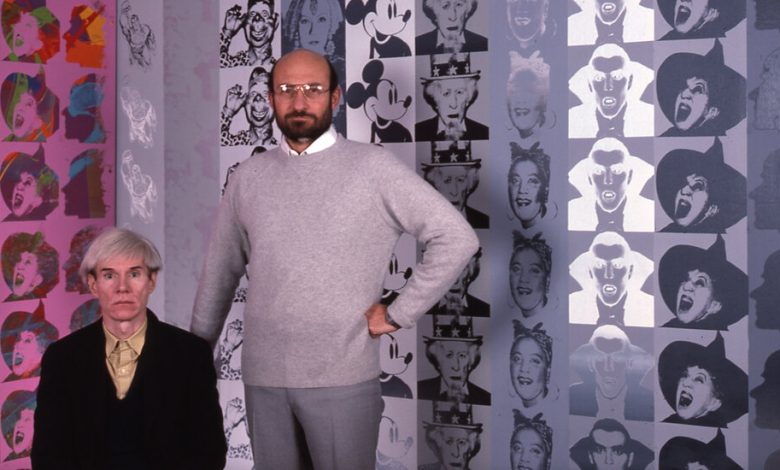Ronald Feldman, Art Gallerist With an Eye for Politics, Dies at 84

Ronald Feldman, who for nearly 50 years oversaw one of New York’s most consistently political, forward-looking art galleries, died on Dec. 20 at his home in Chappaqua, N.Y. He was 84.
His family said the cause was Alzheimer’s disease.
Trained as a lawyer and deeply interested in politics, Mr. Feldman, at his Ronald Feldman Gallery in SoHo, exhibited artists who pushed boundaries with work that almost always had a political slant.
The list of celebrated artists to whom he gave first or early New York exhibitions included Hannah Wilke, Joseph Beuys, Chris Burden, Eleanor Antin, Pepon Osorio, Komar and Melamid, Helen and Newton Harrison, Ilya Kabakov, Ida Applebroog, Ed Schlossberg and Arakawa.
Before it was fashionable, these artists often focused on women’s rights, the environment, totalitarianism, identity and war.
In time, they spanned several generations, from the figurative painter Leon Golub to members of younger generations like Christine Hill, Keith Cottingham, Roxy Paine and Rico Gatson. But the gallery also showed abstract painters like Bruce Pearson and Carl Fudge, whose approaches to their art were markedly irreverent. Mr. Feldman published some of Andy Warhol’s first-edition silk-screen prints.
In a public interview in 2010 with the museum director and curator Stuart Horodner at the Atlanta Contemporary art center, Mr. Feldman said that in the beginning he had no idea that “running a gallery was a 24-hour-a-day job,” even though he had chosen to become a dealer in order to “take great risks.”
“We were bankrupt on paper many times over the years,” he said.
His goal, he told Mr. Horodner, was “to find artists that would make statements relevant to their time,” though he did not always expect them to catch on quickly with the public. Several of his artists became successful, but others did not. Still, his commitment to them rarely faltered.
“As long as you’re getting fed by artists,” he said, “you want to stay with them.”
Ira Ronald Feldman was born on April 25, 1938, in the Bronx to Irving amd Judith (Solon) Feldman. His father was the president of a drug company. Ronald grew up in Long Beach, N.Y; earned a B.A. from Syracuse University and a law degree from New York University Law School; and then served in the Air National Guard in Mississippi and Texas for six months.
Upon his return in 1963, he married Frayda Futterman, who had grown up in Larchmont, N.Y., and was working at the McCall publishing company. They met when they were asked to be godparents to a son of mutual friends.
She survives him, as do their two sons, Mark and Andy; their daughter, Julie Golovcsenko; and eight grandchildren.
After law school Mr. Feldman joined a small New York law firm, and he and his wife began visiting galleries and museums. He rose to partner at his firm in three years, but by then he had realized, as he told Mr. Horodner, “I wanted to be a protagonist in a different way,” on behalf of artists, not legal clients.
In 1971, the Feldmans opened a gallery on the ground floor of a small townhouse on East 74th Street in Manhattan, just around the corner from the Whitney Museum of American Art. They intended to be private dealers, but a friend, the painter Ed Moses, asked if he could show his work there; they said yes and never looked back.
Within a short time, exhibitions were devoted to the feminist sculptor and performance artist Hannah Wilke, the German sculptor Joseph Beuys (who was just becoming well known in the United States), the innovative early modernist Marcel Duchamp and Chris Burden, an inventor of endurance performance art.
Warhol was a frequent visitor, perhaps because the space had been the final home of Eleanor Ward’s Stable Gallery. In 1962, Warhol had his first show of Pop Art at the Ward gallery’s original address, a former stable on West 58th Street.
On many visits Warhol would ask Mr. Feldman a question he sometimes posed to people: “Do you have an idea for me?” Mr. Feldman eventually came up with an idea that appealed to Warhol, resulting in “Ten Jews of the 20th Century,” portraits published in 1980 and first exhibited at the Jewish Museum in Manhattan.
Mr. Feldman was active in Democratic politics, raising money through benefits at the gallery and helping other galleries organize them.
President Bill Clinton appointed him to the National Council on the Arts. He also served on the boards of People for the American Way, Creative Capital, the Art Dealers Association of America and the New School’s Vera List Center for Art and Politics.
In 1987, when there were grumblings that the Vatican’s restoration of Michelangelo’s ceiling in the Sistine Chapel might be doing more harm than good to the work, he got a number of artists to sign a petition asking the Vatican to pause the project and reconsider it.
The petition had no effect, but the prominence of the signatories illustrated Mr. Feldman’s art world sway. Among them were Robert Rauschenberg, Robert Motherwell, Susan Rothenberg, Eric Fischl and Christo.
